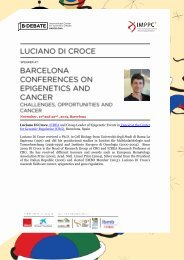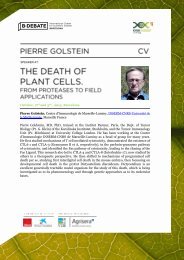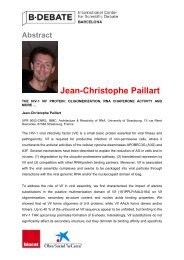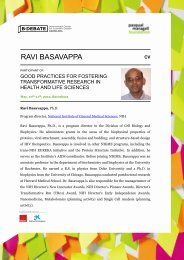CV and abstract Ikuko Hara-Nishimura - B·Debate
CV and abstract Ikuko Hara-Nishimura - B·Debate
CV and abstract Ikuko Hara-Nishimura - B·Debate
Create successful ePaper yourself
Turn your PDF publications into a flip-book with our unique Google optimized e-Paper software.
SPEAKER AT:October, 2 nd <strong>and</strong> 3 rd , 2013, Barcelona<strong>Ikuko</strong> <strong>Hara</strong>-<strong>Nishimura</strong>, Professor at Kyoto University, Kyoto, Japan<strong>Ikuko</strong> <strong>Hara</strong>-<strong>Nishimura</strong> received her Ph.D. in Osaka University. She was a researchassistant in Natural Institute for Basic Biology between 1990 <strong>and</strong> 1997, <strong>and</strong> then becameassociate professor until 1999. Since 1999 <strong>Ikuko</strong> <strong>Hara</strong>-<strong>Nishimura</strong> is Professor at KyotoUniversity. She received the Japanese Society of Plant Physiologists Award in 2013, thePrize for Science <strong>and</strong> Technology <strong>and</strong> the Commendation for Science <strong>and</strong> Technology byMEXT in 2007, <strong>and</strong> the Chunichi Cultural Prize in 2006. She currently is member ofReview Panel of MEXT (Government of Japan). She also was member of the Expert Panelon Basic Policy of Council for Science <strong>and</strong> Technology Policy at Cabinet Office(Government of Japan) between 2007 <strong>and</strong> 2011; the Review Panel of Ministry ofAgriculture, Forestry <strong>and</strong> Fisheries <strong>and</strong> Research Council between 2005 <strong>and</strong> 2009, <strong>and</strong> theReview Panel at Council for Science <strong>and</strong> Technology Policy in 2007 <strong>and</strong> 2008.
SPEAKER AT:October, 2 nd <strong>and</strong> 3 rd , 2013, BarcelonaEndomembrane Systems Responsible for Defense Strategies of PlantsPlant endomembranes including vacuoles <strong>and</strong> endoplasmic reticulum dynamically move<strong>and</strong> change their shapes within the cells. Previously, we reported that plants use vacuolesfor cell autonomous plant immunity in two different ways. The first way involves fusion ofvacuolar membrane <strong>and</strong> plasma membrane, which is triggered by the a virulent bacteriainfection <strong>and</strong> allows vacuolar defense proteins to be discharged into the extracellular spacewhere the bacteria proliferate. The fusion of vacuolar <strong>and</strong> plasma membranes is induced ina proteasome-dependent manner. The second way is associated with vacuolar membranecollapse followed by the release of vacuolar hydrolytic enzymes into the cytosol, resultingin rapid <strong>and</strong> direct cell death. This way is effective in the digestion of viruses proliferatingin the cytosol. Intriguingly, both vacuole-mediated immune systems induce hypersensitivecell death by using caspase-like activities: caspase-3-like activity (DEVDase activity) ofproteasome subunit PBA1 causes the membrane fusion, while caspases-1-like activity(YVADase activity) of VPE causes the vacuolar membrane collapse. In this meeting, wealso touch on another ingenious two-compartment immune system, in which betaglucosidasesin the ER bodies of epidermal cells of roots <strong>and</strong> the vacuoles of myrosin cellsof leaves are sequestered from their glucosinolate substrate. When cells are ruptured byherbivores, myrosinase converts the substrates into a toxic compound. These resultsprovide an idea that plants use the vacuoles differently depending on the type ofpathogenic organisms.











